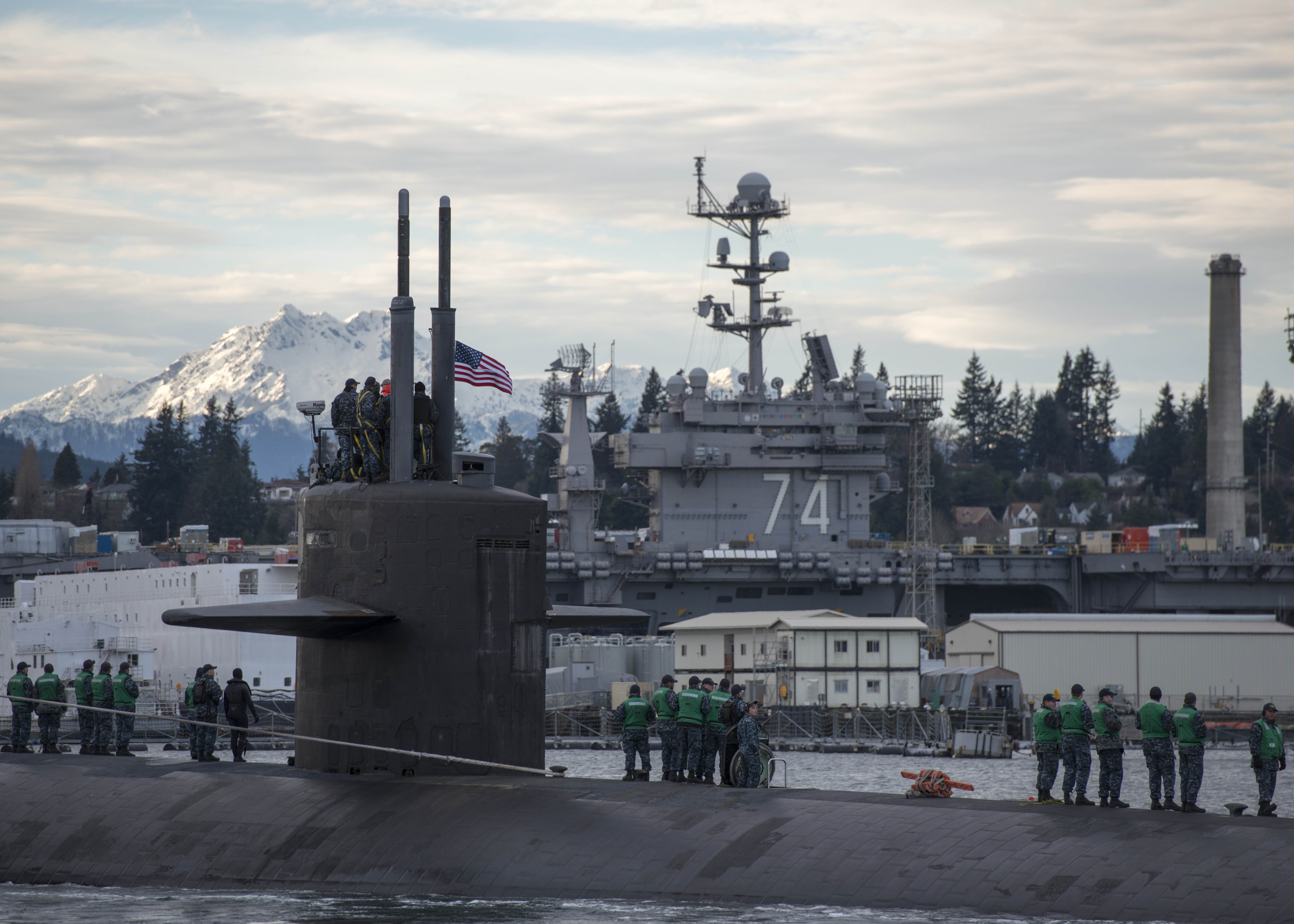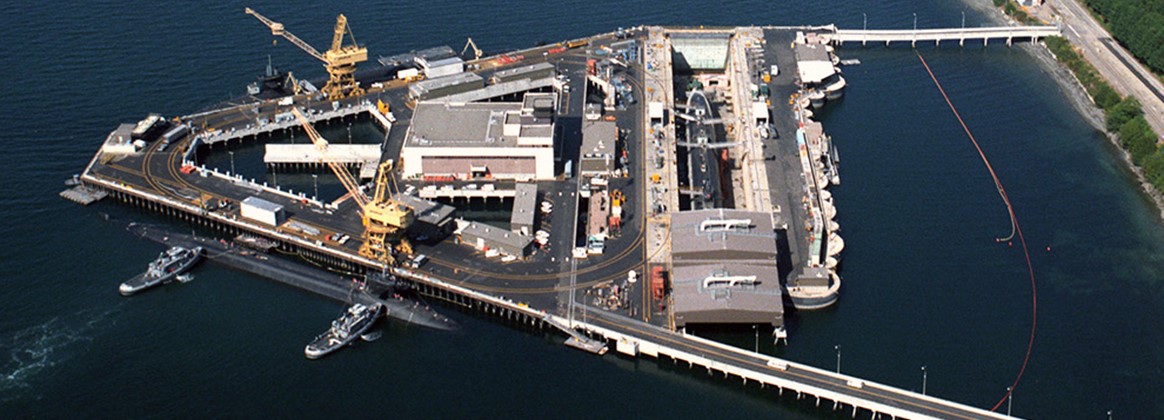
The Los Angeles-class fast-attack submarine USS Olympia (SSN-717) arrives at Puget Sound Naval Shipyard for a port visit in January 2017. US Navy photo.
Four dry docks the Navy uses to overhaul nuclear submarines in Washington are temporarily closed after the service found they are at risk for earthquake damage, service officials told USNI News on Thursday.
The dry docks, three at Puget Sound Naval Shipyard & Intermediate Maintenance Facility in Bremerton, Wash., and the delta pier at the Trident Refit Facility in Bangor, Wash., are still certified to overhaul nuclear submarines, but the Navy has decided to keep the dry docks empty pending further investigation.
“The seismic assessment and expert validation enhances the Navy’s knowledge of the potential issues associated with a large earthquake occurring during a submarine maintenance availability,” reads a statement from the service.
“With this new knowledge, the Navy determined that it needs to remediate specific vulnerabilities to ensure the safety of the shipyard workforce, sailors, the local public, the environment and the submarines.”
As a result of the findings, the Navy over the last week brought in about one hundred experts from across the fleet and outside the service to assess the seismic risk to the dry docks, a Navy official told USNI News.
“The risks are still not fully quantified. What we’re doing is no different from what anyone in the Northwest that has facilities is doing – the risk is not localized here. It’s really a regional risk,” a separate service official told USNI News.
The pause at the dry docks will not result in the reduction of the 14,000 personnel working at the yard, the Navy said on Thursday.
The Navy established PNSY in 1901, with the oldest of the six dry docks originally built in 1906. The dry docks the service has closed are four of the newest ones. Dry Dock 4 and 5 were both built in the early 1940s, while Dry Dock 6 – used for aircraft carrier overhauls – was completed in 1962.
The delta dry dock that’s 13 miles away in Bangor was completed in the 1980s as part of the Navy’s support systems for its nuclear ballistic-missile submarine fleet.
“They are all constructed differently and out of an abundance of caution we want to take a look at all of them,” a second Navy official told USNI News.
The Navy has for years known of the seismic risk to Puget Sound, as the facility sits on multiple fault lines, USNI News understands. It’s unclear what new information the Navy gleaned from the recent seismic assessment.
The yards in Bremerton and Bangor sit near a major fault line that runs from Northern Vancouver Island to Cape Mendocino, Calif. In 2001, an earthquake with an epicenter near the shipyard prompted the service to look at the risk to the shipyard.
“Following the 2001 Nisqually earthquake, seismic vulnerability studies identified high-risk facilities in the shipyard, and in response, the Navy began planning and implementing significant seismic upgrades,” reads a Thursday statement from the Navy.
“The Navy continues to plan and conduct upgrades; several projects are in progress, and the remaining facilities will be addressed as part of the Shipyard Infrastructure Optimization Program.”
An overhaul to the dry docks that would allow them to better sustain earthquake damage could take somewhere between 18 and 24 months, based on previous Navy assessments, USNI News understands. That kind of work could include removing the floor and sides of a dry dock and using different types of sand to absorb motion in the case of an earthquake.
It’s unclear how the pause in the four dry docks will affect the backlog of nuclear submarine maintenance in the service’s four public shipyards. According to a 2020 Government Accountability Office report, the Navy had more than 4,000 days of delays in submarine maintenance between Fiscal Year 2015 and FY 2019.
Program Executive Officer for Attack Submarines Rear Adm. Jonathan Rucker in November said 18 of the Navy’s 50 attack submarines were in maintenance or waiting to go into a yard for an availability.
The Navy brought down its average number of maintenance days from 1,500 to 1,600 in FY 2019 to about 1,100 in FY 2022, Rucker said at the time. The Navy hopes for that number to go down to 700 days by FY 2026.
Given the physical characteristics of submarine maintenance work, a limited amount of it can get done pierside, USNI News understands.
While the Navy could divert some attack submarine maintenance to other locations like Point Loma, Calif., and even potentially Guam, Puget Sound and Pearl Harbor Naval Shipyard are working through a backlog of submarines.
When factoring in the potential for a conflict in the Indo-Pacific and accidents like the 2021 incident with USS Connecticut (SSN-22), which hit an uncharted sea mount in the South China Sea, the capacity could become further strained.
The ballistic-missile submarine work at Bangor, however, could become a more immediate issue. SSBNs go into the Trident facility for shorter, more intense maintenance periods that average about 40 days before heading back out for patrols. This allows the Navy to surge the sea-based leg of the nuclear triad when necessary.
For now, the Navy is continuing to analyze mitigation efforts for the dry docks and is unsure as to when it will reopen them.
“We’ve got a hundred people across different organizations and different seismic backgrounds that are bringing some unique solutions and ideas to this,” the first Navy official told USNI News.
“The Department of Defense pulled out all the stops to try and get the right people together quickly to go after this.”
"sound" - Google News
January 28, 2023 at 02:25AM
https://ift.tt/aCxqQbO
Navy Closes 4 Puget Sound Submarine Dry Docks Following Earthquake Risk Study - USNI News - USNI News
"sound" - Google News
https://ift.tt/rMIxtKN
Shoes Man Tutorial
Pos News Update
Meme Update
Korean Entertainment News
Japan News Update


No comments:
Post a Comment